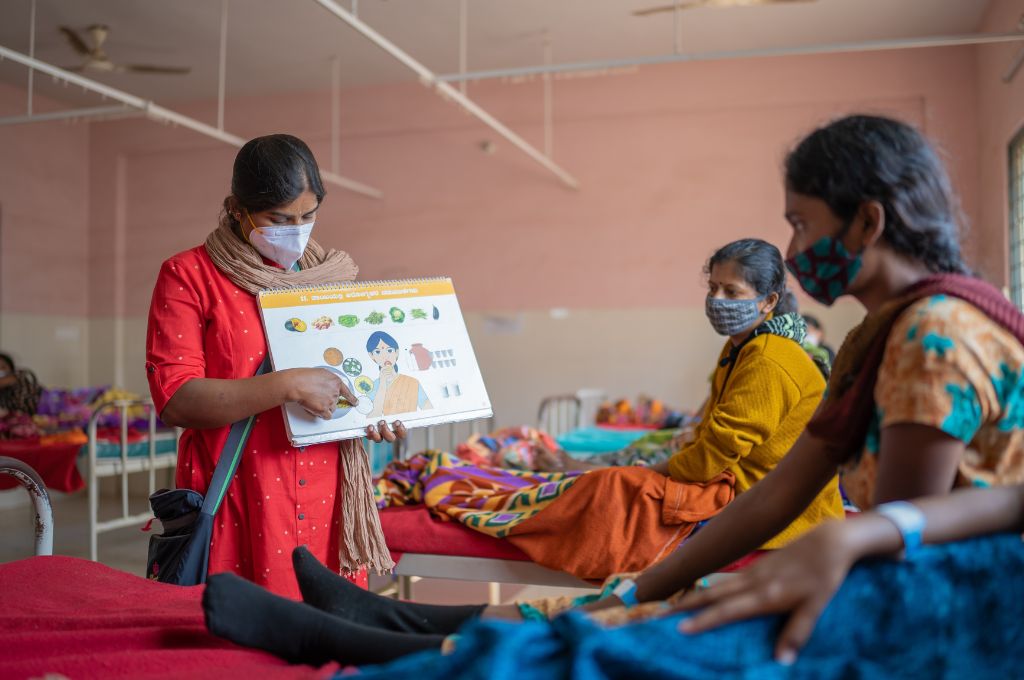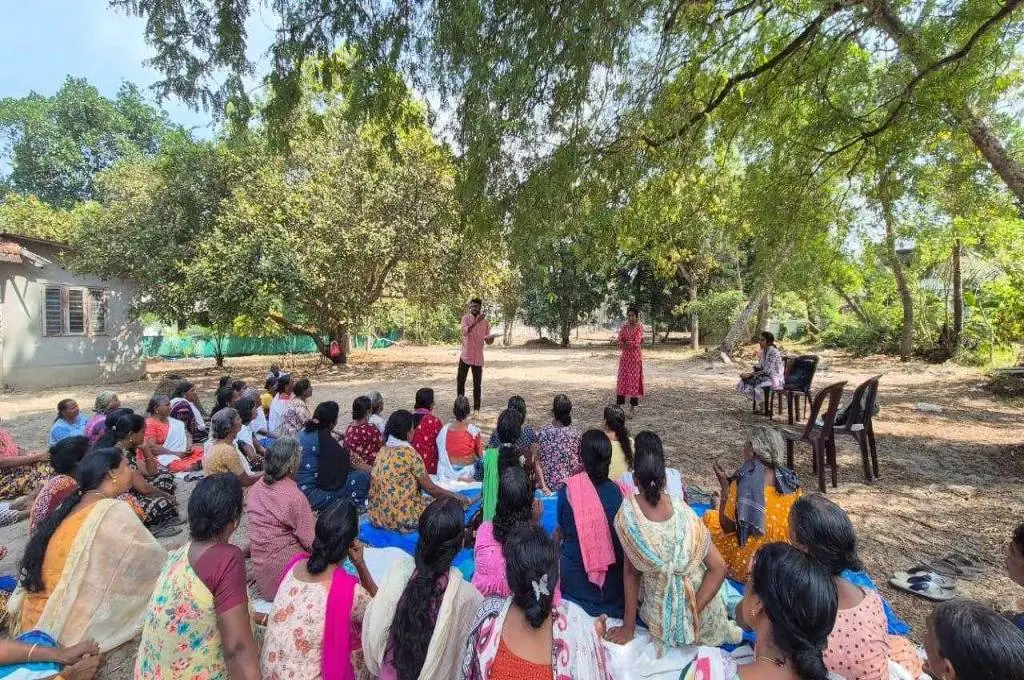According to IDEO, analogous inspiration projects are “a form of exploration that takes a team outside of its industry to find inspiration in the ways others have tackled similar challenges”. With a fresh perspective, we often develop creative solutions to the challenges we face.
This idea led Noora Health—a nonprofit that works with health systems to improve health outcomes by equipping family caregivers with the skills they need to care for their loved ones—to conduct an analogous inspiration project to draw perspectives from the education sector. The aim was to put these learnings into practice through our Care Companion Program, which has typically been viewed through the lens of public health, but can also benefit from deeper investigations of other fields.
Through interviews with 12 experts in the education space, we gained insight into how we might strengthen our programming, with a particular focus on increasing our effectiveness as trainers and educators in the health sector. The project also revealed the larger need for the health sector to learn from the education sector.

This article captures five key learnings, highlighting what public health can learn from education.
Learning #1: Staying motivated
Motivation is why we do what we do. Teachers and nurses often do what they do because their work gives them purpose and the joy of contributing to their communities. Without motivation, teaching or medicine can be very emotionally and physically demanding fields and difficult to cope with.
From our interviews, we noted that motivation can be broken down into two types: financial and non-financial. When asked about methods of non-financial (or intrinsic) motivation, participants expressed that the key motivator for teachers was a sense of ownership in their work. There are multiple ways of achieving this, such as involving teachers as co-designers of curriculum, increasing their participation in decision-making, or adopting a democratic leadership style.
STIR Education, an international nonprofit that supports education systems to increase intrinsic motivation in every teacher, shared that this form of motivation is only possible when teachers understand their purpose and have the space to succeed and fail. This leads them on the path to continuous improvement and “continual improvement leads to mastery”. The Citizens Foundation (TCF), one of Pakistan’s leading organisations in the field of education for the less privileged, was able to successfully maintain the motivation of local teachers by drawing on their sentiment to give back to their own communities—an idea known as ‘purpose-driven motivation’.
On the other hand, an example of a financial motivator is TCF’s performance-based pay approach. TCF administers competency tests for teachers on a yearly basis. The teachers who score well on these tests are rewarded with an increase in salary, thereby incentivising performance.

However, Maansa, an educator and PhD student at the University of Canterbury, argues that extrinsic motivation has many negative effects. This is because if a person gets used to external rewards, intrinsic motivation starts to decline. At that point, she notes, “It’s difficult to keep that spark alive, and that’s (the spark) why teachers are in it.”
It is important to note that for both nurses and teachers from underserved backgrounds, the extra financial incentive can have a lasting impact on their lives. However, such financial motivation techniques should always be coupled with non-financial or intrinsic motivation. This can take the form of appreciation—through a nurse of the month programme, for example—or increased autonomy and involvement in decision-making. As healthcare organisations work towards building the motivation of their nurses, they must prioritise maintaining the ‘spark’ with which nurses enter their field of work.

Learning #2: Increasing the role and relevance of technology
Our participants shared three benefits of incorporating technology into their classrooms: teacher aids, personalisation of education, and accessibility of education.
As the pandemic has revealed, technology enables remote learning opportunities, reaching students that may otherwise not have had access to education.
For low-resourced areas, technology can support in-class instruction or help teachers prepare for lessons beforehand. This model is used by Meghshala, an organisation that developed a teacher preparation programme on an app that allows teachers to prepare for lessons without feeling overwhelmed or overburdened. STIR Education recommends that in such scenarios where technology serves as a teaching aid, it must be flexible enough to adjust the model for each context. This is what TagHive, a Samsung-funded education technology company, aims to do at the school level by tailoring the content to each school’s curriculum and needs. Artificial intelligence assesses the child’s learning level, and the content is then tailored accordingly without the teacher’s assistance. The child, therefore, is never asked a question they are ill-equipped to answer. Finally, as the pandemic has revealed, technology enables remote learning opportunities, reaching students that may otherwise not have had access to education.
Given the role of technology as an educational aid, Noora Health also identified multiple ways in which technology can be utilised to promote health outcomes through better monitoring and communication. These include improving the ability of patients to access information about their health remotely and increasing the accessibility of remote communication with healthcare professionals so that patients can ask about personal concerns and receive feedback on their health. Similar to its role in supporting teachers, technology can provide nurses with an informational aid that can be accessed on their personal devices on the go.
Learning #3: Understanding the importance of context, community, and collaboration
Collaboration between parents, teachers, school administrators, governments, and the larger community is central for quality education. Sridhar, a former Teach for India fellow and current senior associate at IDFC Institute, mentions how feedback from family members on their children’s education provides a more holistic picture of student learning.
Similarly, before building their educational app, the Upepo team spoke with parents to ensure the app was in line with parent aspirations. Additionally, whether or not an education intervention is discussed in community gatherings can be an indicator for success. Sridhar notes, “There are folks who are not in the traditional loop but can give you an idea about the quality of your programmes, for example, the shopkeeper who sells the children snacks.” Given their role as trusted community insiders, these individuals are able to gather authentic and informal feedback about various community interventions—education and health alike—that may be able to help practitioners identify the strengths and weaknesses of their programmes.
It is also important for educators to collaborate internally. Maansa shares how, in her experience as a teacher, the teachers would meet regularly to discuss strategies and challenges. Similarly, others note how helpful it has been for them to connect with those who have taught at the same school to be able to identify where the issues are arising and how to address them.
Education relies heavily on community, context, and collaboration.
Alini Singh, an English teacher at Ingraham Institute, Ghaziabad, notes that “who you’re teaching is very important, the students and their diverse backgrounds matter”. Without a full understanding of how their diverse backgrounds impact their experience, the organisation may fail to sufficiently address the needs of their communities. Moreover, Maamta, an educator at the Milaan Foundation, notes that “educators must know each child very well otherwise many times the problems cannot be dealt with”.
Education relies heavily on community, context, and collaboration. A child is not isolated in their educational experience, nor is a patient in their journey to health. Any intervention affects the community at large, be it family, friends, or other community members. This understanding of context and community allows us to better tailor our programming to accommodate for the diverse experiences of health and treatment with our patients and patient families. To ensure that we provide the optimal care and support for every patient, our health recommendations must be modified according to the culture, customs, and context of our patients. For example, any recommendations on diet for maternal health must take into account the availability of local ingredients, the cost of purchasing various food items, the religious and cultural dietary restrictions, and so on.
When we design for everyone, we design for no one. By tailoring our health recommendations to the context and culture of our patients, we are able to provide solutions that are sustainable.
Learning #4: Investing in people
Investing in the growth and development of the team is the best way to ensure that organisational goals are continually met.
Participants shared that they found training helped reduce stagnation and ensure improvement. Maansa shares that administrators and trainers must “challenge (teachers) from a genuine space, instead of from intimidation”, emphasising the importance of adopting kindness as part of the training and mentoring process. The training provided should be jargon-free to make it as accessible as possible. The sessions should be actionable (and not limited to theory) to ensure that the learnings from training can be easily applied to the classroom context. Reflecting on her time as a trainer and teacher, Maansa noted the need to mindfully develop training sessions that have significant break time. This is because teachers come into these training sessions, which are often held at the end of the day, feeling exhausted and burned out. She recommends that the trainings should not cognitively overload the participants and that every session should end with a reflection and an actionable takeaway. “Adopt a human-centred learning approach”, Maansa emphasises.
Jump Design India, a design studio for education products, curriculum, and design research, further highlights the need to be mindful of teacher burnout: “Any additional intervention or training for teachers beyond work hours should be well thought of and well scheduled.”
Make a Difference, a nonprofit that works with children in orphanages and shelters across India, echoes Maansa’s and Jump Design India’s sentiments. They discuss how ‘lecture-y sessions’ should be avoided and instead trainings should involve teaching through interactive and action-based activities. When designing their sessions, Make a Difference assumes that no one has previous experience in the space. The designers of teacher trainings ask themselves: What are the most basic things someone requires to be successful in a classroom? Additionally, the training should have a sense of growth where trainees can ‘level up’ if they’ve been through the early modules of training. The content of the trainings should be revised every year to ensure that only the most relevant practices and information are shared.
These experiences shine a light on the importance of investing in people and the impact it can have on the organisation and its mission. Within Noora Health’s context, we learned why nurses should be able to request training on particular topics or serve as co-creators for their own training sessions, should they be inclined to do so. It will also be of great benefit to healthcare workers if they are provided with additional training to prepare them to take on the role of a facilitator, teacher, and trainer—roles that they may often find themselves in during their time as healthcare professionals.
Learning #5: Recognising the need for organisational support
Organisations can play an important role in ensuring the success of its teaching staff. To build a sense of community among the staff, organisations must provide high levels of continued support. Maamta expands that this is only possible when there is trust between the educators and administrators. “Quality requires trust. They must trust that the organisation is doing the right thing.”
For this to happen, the relationship between teachers and administrators shouldn’t be unidirectional. Teachers should feel free to share their dissent and receive personalised feedback and have opportunities to seek mentorship.
Additionally, administrators must meet the needs of the staff. For example, at Protsahan, an organisation working on education for girls, anganwadi workers often approach administrators and ask for training for themselves and their community. Another example is the Akanksha Foundation, where the organisation makes sure that each school gets its own social workers. Successful organisations are able to meet the needs of the community and educators as needs arise.
TCF also remains deeply connected with their teachers through training. Their training team hosts school visits so that they don’t become too divorced from the teachers and ground reality. Sridhar agrees with this model, noting that the organisation must “become an ‘insider’ in the life of (their) teachers to ensure there is no disconnect”.
Public health and education overlap in a shared mission to benefit the communities they work in.
Maansa thinks back to the time her mother was a teacher, and shares, “Be involved with your team of teachers. Be there every morning to say good morning. Be around and available; teachers should feel your presence. Develop a true democratic environment where teachers feel like they belong. Teachers are happiest when they have a strong relationship with the management. Don’t let them feel alone.”
In the healthcare context, we must consider how we can provide nurses with the platform to voice dissent, communicate freely with administrators about their concerns and ideas, and feel like an integral part of the hospital and patient education environment. Ways to provide sufficient support include having frequent and open communication between nurses who are on the ground and administrators who are behind the scenes and involving nurses in decision-making whenever possible, particularly when decisions that may impact their day-to-day work are being made.
To sum up, analogous projects allow us to step outside ourselves. In doing so, they have the potential to inspire us to see our world from a different lens, collaborate with new and diverse industries and individuals, and creatively identify solutions to problems. Public health and education overlap in a shared mission to benefit the communities they work in. Learning from each other opens the door to limitless possibilities of becoming better educators, better healthcare workers, and, most importantly, better caregivers.
This is an edited version of an article that was originally published on the Noora Health blog.
—
Know more
- Watch this TED talk to learn more about the role that caregivers can play in improving patient well-being.
- Read this paper to understand more about the challenges facing nursing education in India.
- Learn more about what kept teachers motivated during the pandemic.




